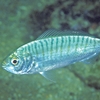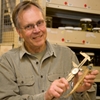General Description
A relatively large goby; head moderately long, triangular in cross-section; eyes close together near top of head; mouth terminal, oblique, reaching almost to below middle of eye. Body overall brown, with darker mottling on back and cheek, and a thin dark diagonal line from eye to rear margin of jaws; midsides with 6-8 irregular darker blotches, and a dark round spot at the base of the tail; upper part of pectoral-fin base with a short horizontal dark bar; dorsal and caudal fins with fine speckled lines; pectoral fins yellow. To 25 cm.
Biology
This species is native to waters in Japan, Korea and China. It was accidentally introduced to Australia and California when juveniles or larvae were transported in ballast water in ships and the water was released in ports of call. Ships heading to Australia must now release their ballast water far offshore. In 1990, the Yellowfin Goby was discovered in Port Phillip Bay and was subsequently found in large numbers in the western part of the Bay and in the lower reaches of the Yarra River. The species is now rare in Australia.
Habitat
Builds burrows on muddy bottoms in shallow estuaries, harbours and in the lower reaches of rivers and streams.
Soft substrates
Distribution guide
Japan, Korea and China. In Australia, recorded from New South Wales and Port Phillip (Victoria).
Species Group
Depth
Water Column
Max Size
25 cm
Commercial Species
No
Global Dispersal
Introduced to Australia
Identify
Conservation Status
- DSE Advisory List : Not listed
- EPBC Act 1999 : Not listed
- IUCN Red List : Not listed





